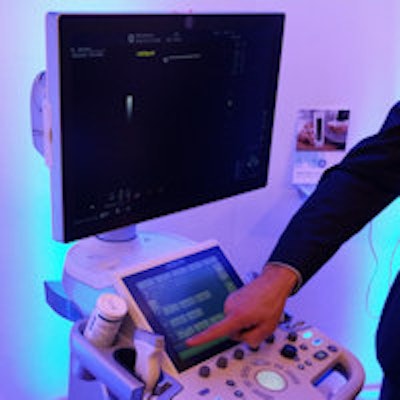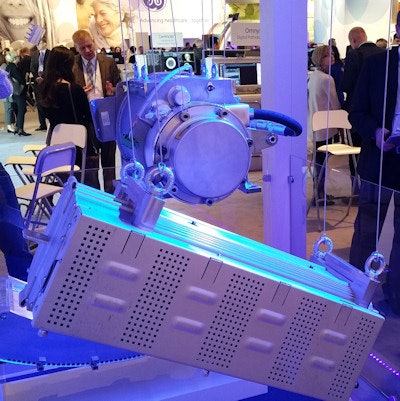
VIENNA - GE Healthcare is highlighting a pair of new MRI scanners, Signa Creator and Signa Explorer, making their global launch at this week's ECR 2015 meeting. The company is also rolling out its new Logiq P9 ultrasound scanner, as well as Centricity xSite, a new healthcare IT platform designed to improve radiology reporting across multiple healthcare enterprises.
Creator and Explorer are new 1.5-tesla MRI scanners designed for smaller spaces and to use 34% less power for operation. Creator is an entry-level system intended to be a reliable workhorse, while Explorer occupies a price point a level up.
Both units include GE's Continuum Pak software to support better workflow and improved image quality. Explorer will be available with GE's SilentScan noise reduction technology, and GE will offer users in its installed base of 1.5-tesla scanners an upgrade path to the new system.
The systems have received the CE Mark, with the first Explorer system installed last week in the Netherlands.
In other news, GE entered the hybrid PET/MRI market at RSNA 2014 with Signa PET/MRI; at ECR 2015, GE is reporting that the scanner has now been installed at four sites and the company is getting good feedback from users.
 GE's new Logiq P9 ultrasound scanner.
GE's new Logiq P9 ultrasound scanner.Signa Pioneer is a flagship 3-tesla scanner that also was introduced at RSNA 2014, and GE is giving ECR 2015 attendees a first look at the unit, which does not yet have the CE Mark. The scanner includes a productivity protocol called magnetic resonance image compilation (MAGiC), which enables users to create scans with six different contrast settings in a single exam.
MAGiC can reduce the need for rescanning by enabling radiologists to use one of the alternative views if they are dissatisfied with results from their original protocol. GE is expecting the CE Mark for MAGiC in the summer of 2015, and it also plans to roll out the technology on other MRI systems.
Logiq P9 is a midrange ultrasound scanner being launched globally at ECR 2015. The unit sports a large monitor, customizable touchscreen, and simplified console, according to the vendor, with users able to complete exams 32% faster than with previous GE systems.
One of the productivity tools on the scanner is My Page, which allows users to save their user preferences and easily access key functions. The first Logiq P9 was installed in South Korea last week and will ship in Europe in March or April; it will not initially be available in the U.S.
GE is also showing the Logiq E9 and Logiq S7 scanners shown at RSNA 2014. E9 is getting a liver imaging package that includes shear-wave elastography and also volume navigation technology.
A big highlight in CT is Revolution, the new 512-slice scanner launched at RSNA 2014. At ECR 2015, GE is highlighting cardiac imaging applications possible with the system, as evidenced by a paper presented this week that demonstrates its utility in imaging patients with high heart rates.
Researchers at Centre Cardiologique du Nord (CCN) in Saint-Denis, France, performed coronary CT angiography scans on 58 patients with heart rates greater than 58 beats per minute. They compared Revolution images with those acquired with the previous generation of GE technology, the 128-slice Discovery CT750 HD. Revolution images were judged to have better image quality, and it was possible to image a very high number of coronary segments.
 GE is highlighting the remote service capabilities of its CT technology with this exhibit.
GE is highlighting the remote service capabilities of its CT technology with this exhibit.In x-ray, GE highlights include the Discovery IGS 740 angiography system and Optima XR646 digital radiography unit, while GE is also discussing its DoseWatch program for dose optimization and management, which has been installed at hundreds of hospitals throughout Europe.
Finally, new developments in healthcare IT for GE include Centricity 360, a cloud-based platform for image and data sharing. Centricity 360 has been installed at a site in France, with another installation scheduled for the U.K. soon.
In a new development at ECR 2015, GE is discussing Centricity xSite, a new platform for exam reporting across multiple healthcare sites. xSite functions as a reporting platform that sits on top of whatever radiology reporting and RIS solutions a site is using, and enables multiple sites in a healthcare enterprise to use the same user interface even if they have reporting software from different vendors installed. It also supports cross-site worklist retrieval and subspecialist remote reporting, without the need for a separate database.
The first installation of xSite is in Region Waldviertel in Austria, where a healthcare network of four hospitals and 27 clinics went live with the software last week.
Finally, GE is discussing its Omnyx platform for managing digital pathology images. The software digitizes pathology slides and integrates them with electronic patient records; it received the CE Mark in April 2014, with the first European site installed in Switzerland. Omnyx is not yet available in the U.S.




















